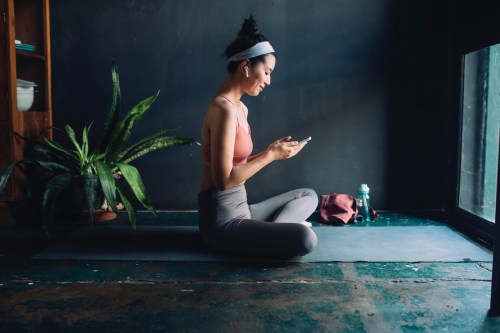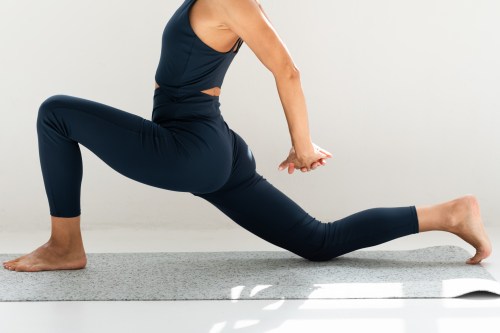Our editors independently select these products. Making a purchase through our links may earn Well+Good a commission
Despite its reputation for being a slow, soothing form of fitness, Pilates can actually be pretty intimidating. Chalk it up to the Reformers, which legit look like medieval torture devices, but kicking off your first Pilates class isn’t exactly super straightforward. To help you get started, we’ve asked trainers for their top tips for Pilates for beginners at home.
If you’ve never done Pilates before, know that it can benefit every single type of athlete out there (yes—even if you prefer more “hard-core” workouts). “If you are someone who likes HIIT workouts, Pilates is a great recovery day workout,” says Rebecca Lubart, founder of Dynamic Body Pilates. That’s because it’s low impact and gentle on the body as it boosts your posture, strength, and flexibility. “The way in which Pilates strengthens your body results is not just being stronger, but being more open and flexible. You’ll feel invigorated, refreshed, and worked-out without feeling ‘dead’ afterwards,” she says, adding that it can be done every day without necessarily needing a rest day.
Though classical Pilates studios tend to use equipment like the Reformer, mat Pilates can be done with smaller workout tools or nothing at all. “Pilates can be done with and without special equipment,” says Lubart. “With remote sessions, we can use props like foam rollers, Therabands, and other tools. It can be done with no props, though often the props can enhance the results.” The main difference with at-home Pilates workouts without the major pieces of equipment lies in the resistance factor. “On the equipment, the spring can add an assistive or resistant component, but that’s where we get clever in using props to create a similar challenge,” says Lubart. Keep scrolling to learn expert-approved Pilates pointers, plus how to get started with the workout at home.
What to know about Pilates workouts
Because doing Pilates at home is a bit different than in a class setting, there are certain things to know before going from zero to hundreds (hundreds are a classic Pilates exercise… LOL).
1. Your core is going to get activated: If there’s one thing that you hear about Pilates time and time again, it’s the fact that the fitness modality is all about your core. “One of the ways Pilates is so effective is that typically your core is engaged in every exercise,” says Lubart. So even if the move that you’re doing feels as though it’s focusing on your glutes or your legs, know that there’s a 99.9 percent chance that your core muscles are being activated in some way or another as well.
2. There’s a special method to breathing in Pilates: Like yoga has yogic breath, Pilates has its own suggested way of breathing. “You shouldn’t be breathing into your belly in Pilates,” says Lubart. “You should breathe into the backs and sides of your ribs instead.” Her tip for doing this properly? Begin by placing your hands on your ribs, fingers in front, and thumbs wrapped to the back of your ribs. Take a gentle breathe as you try to fill the backs and sides of your ribs (“This isn’t a huge breath!”) and on the exhale, soften your breastbone and front ribs down towards the floor. “Let your ribs soften down and together,” she says.
3. Consider investing in Pilates props: At-home Pilates equipment that you can get to upgrade your workout include a Theraband, and foam roller, as Lubart mentioned, along with a light set of dumbbells, an inflatable ball, and a Pilates ring. And a mat, if you don’t have one already.
4. Mat Pilates is more challenging than you think: Don’t be fooled—mat Pilates is not the easy way to get your Pilates in. As Lubart pointed out, the large pieces of Pilates equipment found in studios offer an assistive component… and because of this, mat exercises can be much harder. “Mat work can be the hardest if you have limitations, because you don’t have any equipment to assist you,” says Sarah James, founder of Pilates by Sarah James. “It forces you to connect to your core with no help—which rocks. Most of my clients have been saying that they’re feeling their abs more when focusing on a mat class.”
5. Look for modifications: When you’re starting out, it can be challenging to go directly into a full side plank or a seated forward stretch with straight legs. “Most Pilates exercises can be modified until you have the strength to do the exercise as it is fully intended to be done,” says James, who recommends searching for beginner Pilates videos that offer modifications.
Try these Pilates for beginners at-home workouts for yourself
Teaser
Before you launch into any given workout, you want to nail the moves. The Pilates teaser is one of the most common ab-focused exercises that you’ll do in a Pilates workout. Here’s how to do it right.
Side plank
Another plank you’ll find yourself doing? Side plank—check out these form tips plus how to modify it.
15-minute full-body Pilates workout
Now for the full workouts: Try this round of Pilates exercises to hit every muscle in your body in just 15 minutes.
15-minute Pilates core workout
Work through this 15-minute Pilates core workout that will really get your ab muscles quaking.
Pilates full-body workout
Here’s another full-body Pilates workout… and it only takes 10 minutes, courtesy of trainer Kimmy Kellum.
20-minute Pilates abs, arms, and glutes
In this 20-minute Pilates session, you’ll give special strengthening TLC to your abs, glutes, and arms.
Pilates ring workout
Once you get your hands on a Pilates ring, work your way through this Pilates workout using the exercise prop.
30-minute full-body Pilates workout
For a longer sweat sesh, challenge yourself to complete this 30-minute full-body Pilates workout that requires zero equipment.
Sign Up for Our Daily Newsletter
Get all the latest in wellness, trends, food, fitness, beauty, and more delivered right to your inbox.
Got it, you've been added to our email list.











